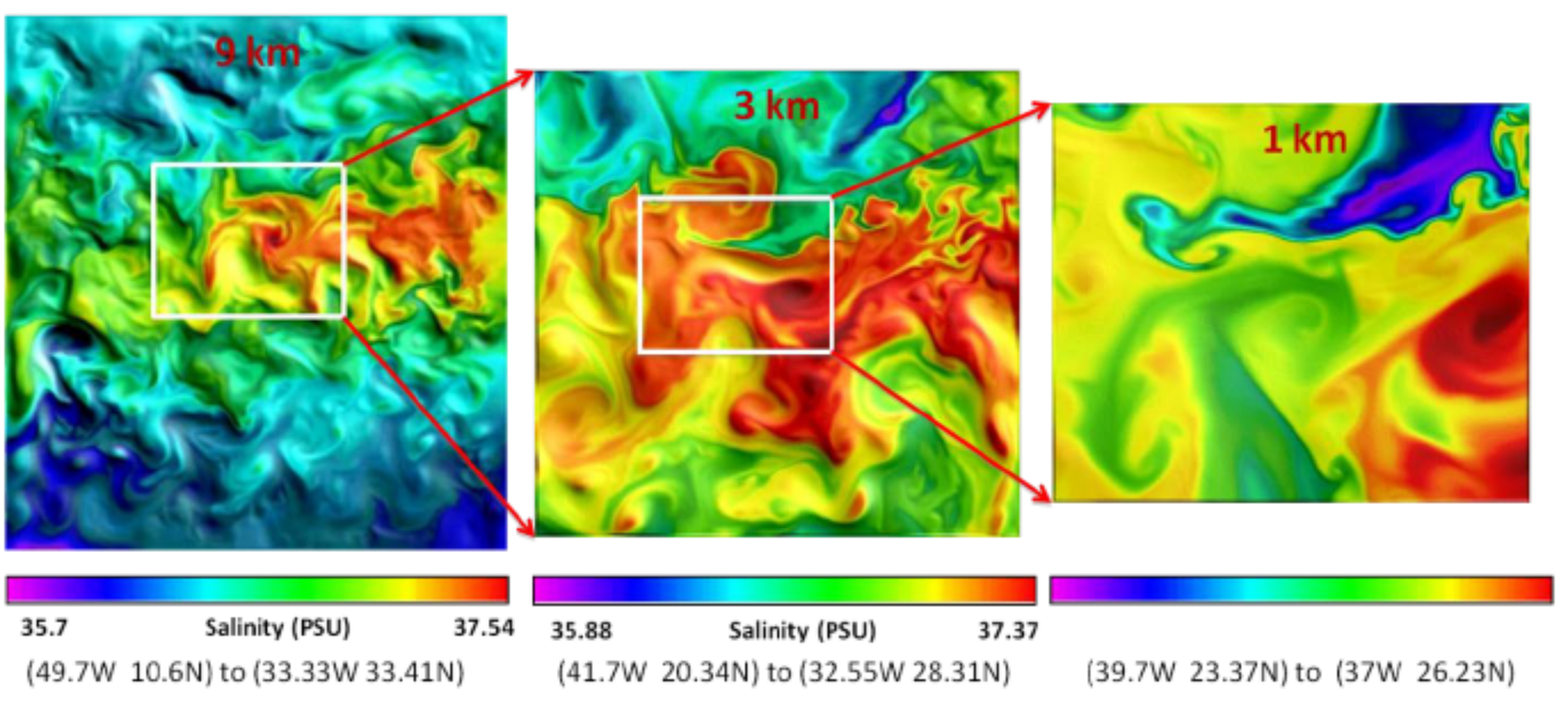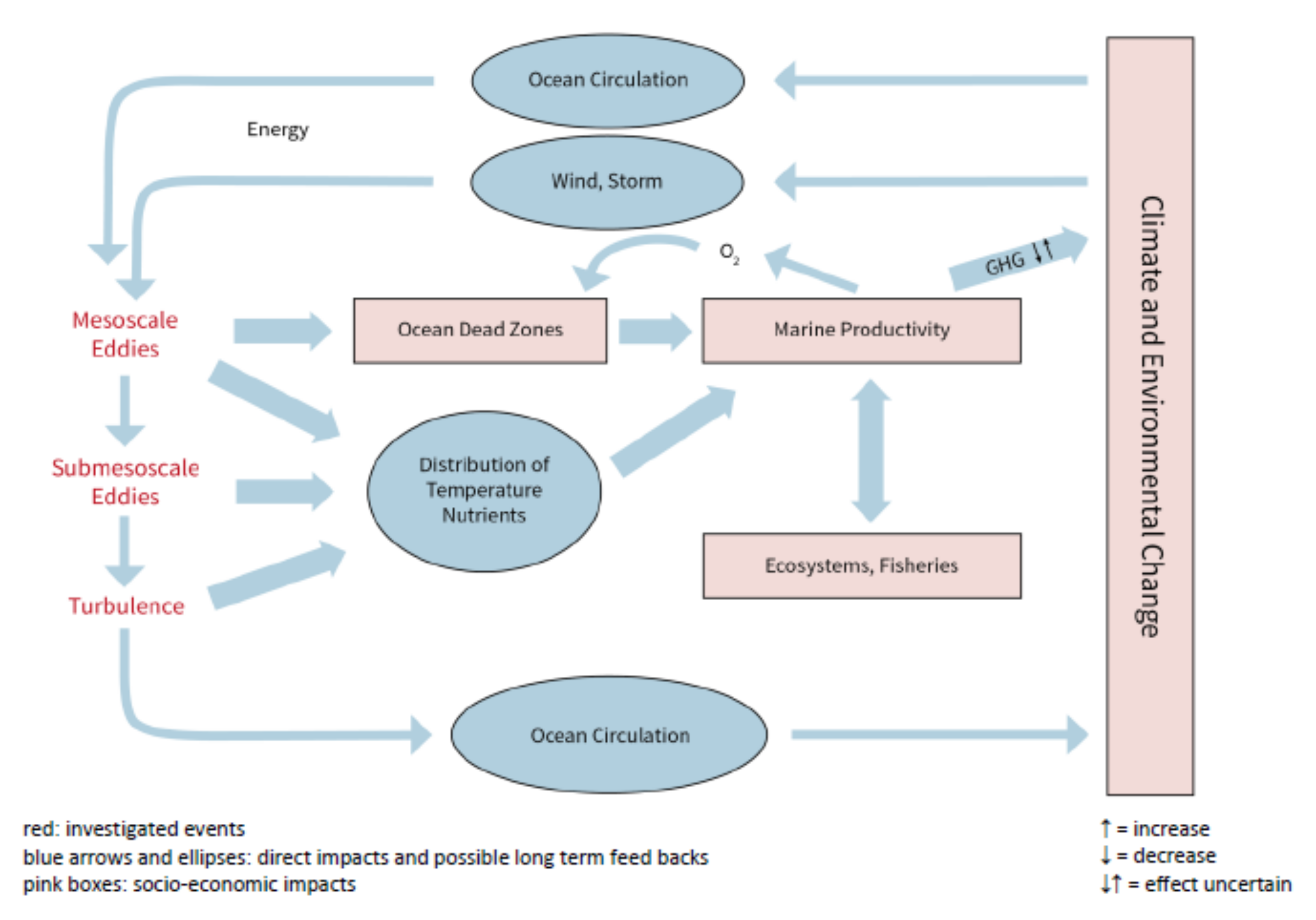Scientific Background and Goals
 Global ocean circulation is driven by wind, tides and the exchange of heat and fresh water with the atmosphere. Large gyres span entire ocean basins, continuously transporting heat from the equator towards the poles. While this large-scale structured flow, such as the Gulf Stream, can be easily identified, high-resolution model simulations have only recently revealed that the ocean and coastal areas are dominated by variability on multiple spatial and temporal scales. Increasing scientific attention is therefore devoted to processes on the mesoscale (up to about 200 km, with a lifetime of many months) to the sub-mesoscale (<1 km to 10 km, with a lifetime of hours to days). One reason for this shift is the significant improvement in observation technology now capable of “seeing” such small-scale structures. Another, and scientifically more important, reason is the increasing evidence that indicates processes operating on small scales significantly alter large-scale budgets. Ocean eddies assert considerable influence on ocean energy storage, nutrient and oxygen supply, productivity and the uptake/release of greenhouse gases. They are therefore triggering an event chain of global relevance. Mesoscale and sub-mesoscale dynamics play a key role in the energy transfer from the large-scale ocean circulation to turbulence, where the energy is finally lost in friction, thus maintaining a constant energy cascade that sustains a balance between energy inputs and losses (see Figure, top right).
Global ocean circulation is driven by wind, tides and the exchange of heat and fresh water with the atmosphere. Large gyres span entire ocean basins, continuously transporting heat from the equator towards the poles. While this large-scale structured flow, such as the Gulf Stream, can be easily identified, high-resolution model simulations have only recently revealed that the ocean and coastal areas are dominated by variability on multiple spatial and temporal scales. Increasing scientific attention is therefore devoted to processes on the mesoscale (up to about 200 km, with a lifetime of many months) to the sub-mesoscale (<1 km to 10 km, with a lifetime of hours to days). One reason for this shift is the significant improvement in observation technology now capable of “seeing” such small-scale structures. Another, and scientifically more important, reason is the increasing evidence that indicates processes operating on small scales significantly alter large-scale budgets. Ocean eddies assert considerable influence on ocean energy storage, nutrient and oxygen supply, productivity and the uptake/release of greenhouse gases. They are therefore triggering an event chain of global relevance. Mesoscale and sub-mesoscale dynamics play a key role in the energy transfer from the large-scale ocean circulation to turbulence, where the energy is finally lost in friction, thus maintaining a constant energy cascade that sustains a balance between energy inputs and losses (see Figure, top right).
 Moreover, it has been shown that mesoscale eddies can create extreme environments such as local open ocean dead zones through a pronounced interplay of meso-/sub-mesoscale dynamics and biogeochemistry. Ocean eddies are also responsible for mixing water masses close to the ocean’s surface layer and supporting the vertical transport of matter between deep waters and the upper ocean, thus mediating, for example, up to approximately 50% of the particle export in subpolar oceans. We are only starting to understand the dominant role of eddies in the onset, magnitude, and biodiversity of biological productivity in the oceans and the resulting stimulation of the biological carbon pump (see Figure left).
Moreover, it has been shown that mesoscale eddies can create extreme environments such as local open ocean dead zones through a pronounced interplay of meso-/sub-mesoscale dynamics and biogeochemistry. Ocean eddies are also responsible for mixing water masses close to the ocean’s surface layer and supporting the vertical transport of matter between deep waters and the upper ocean, thus mediating, for example, up to approximately 50% of the particle export in subpolar oceans. We are only starting to understand the dominant role of eddies in the onset, magnitude, and biodiversity of biological productivity in the oceans and the resulting stimulation of the biological carbon pump (see Figure left).
High-resolution ocean models (see Figure top right) can now resolve scales of a few hundred meters while our observational capabilities still possess significant gaps at these small scales. Satellite resolution typically ranges from hundreds of meters to kilometers with overpasses days apart, while in situ small-scale observations were not possible until recently and are only now becoming available due to improved technologies. The challenge is to resolve fine spatial and short temporal scales simultaneously in order to understand the significantly different dynamics of physical and biogeochemical processes and to assess how small-scale ocean processes interact with the largescale ocean circulation. The role of eddies in the Earth systems is therefore driving a complex event chain within a global system through distinct events in time or space. MOSES aims to close this observational gap (see Figure left).
Hence, a number of highly relevant research questions arise. The proposed multi-faceted MOSES facility will be utilized to test the following hypotheses:
(1) Mesoscale and sub-mesoscale eddies play an important role in transferring energy along the energy cascade from the large-scale circulation to dissipation at the molecular level.
(2) Mesoscale and sub-mesoscale eddies are an important driver in determining onset, magnitude and characteristics of primary production in the ocean and contribute significantly to global primary production.
(3) Mesoscale and sub-mesoscale eddies are important for shaping extreme biogeochemical environments (e.g., pH, oxygen) in the oceans, thus acting as a source/sink function for greenhouse gases.
GEOMAR Modules
The observational units used in this event chain can be grouped into three modules, with the GEOMAR involved mainly in the first and second:
• marine fixed point observatories with bottom and mooring-based systems (moorings, bottom lander and underwater node systems, profiling winches, land-based radar systems)
• marine autonomous vehicles for repeated high-resolution spatial mapping of properties in the water column, at the sea floor and at the air-sea interface (swarm of autonomous underwater vehicles (AUVs), Wave Gliders, ocean gliders)
• marine mobile systems. Instrumentation for vessels, aircraft and/or zeppelin for manned operation during field experiments (remote sensing cameras, towed instrument array, radar systems)
Here, complementary observational characteristics of various individual components are combined to observe complex ocean phenomena occurring in the mesoscale and sub-mesoscale space dimension with time scales ranging from minutes to months. The setup of the entire array is highly flexible and can be tailored in terms of number and types of observation units as well as observation parameters. It will therefore be used to address a wide range of scientific questions with regard to the dynamic coupling of physical-biogeochemical-biological processes. Beyond the investigation of ocean eddies, the ocean and coastal modules of MOSES will be deployed as integral components that concern themes of extreme hydrologic events and permafrost thawing which will also require a real-time data system, including real-time data transfer, quality control, databases and public access as well as high-resolution satellite imagery.
